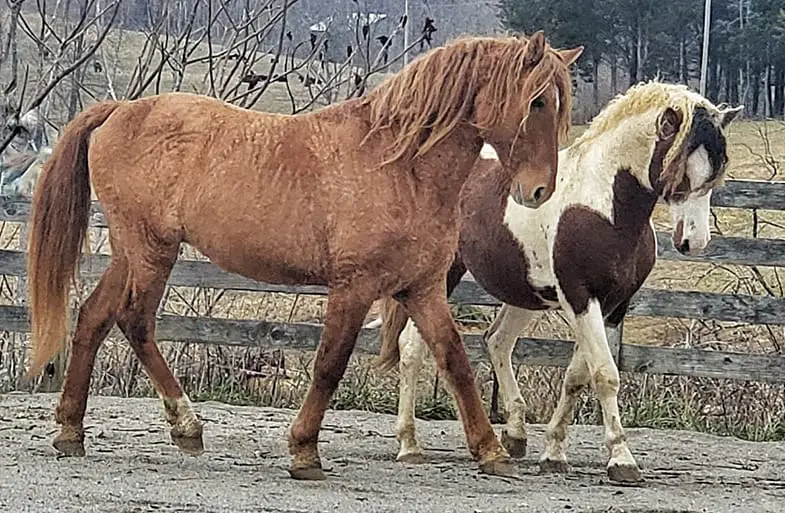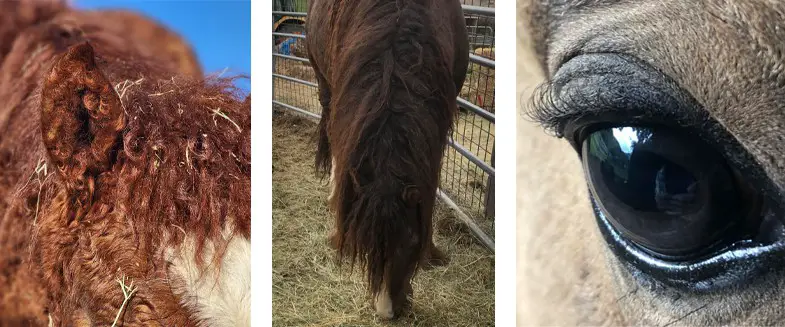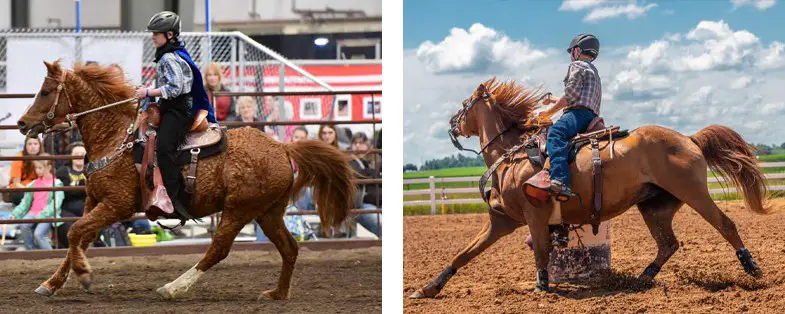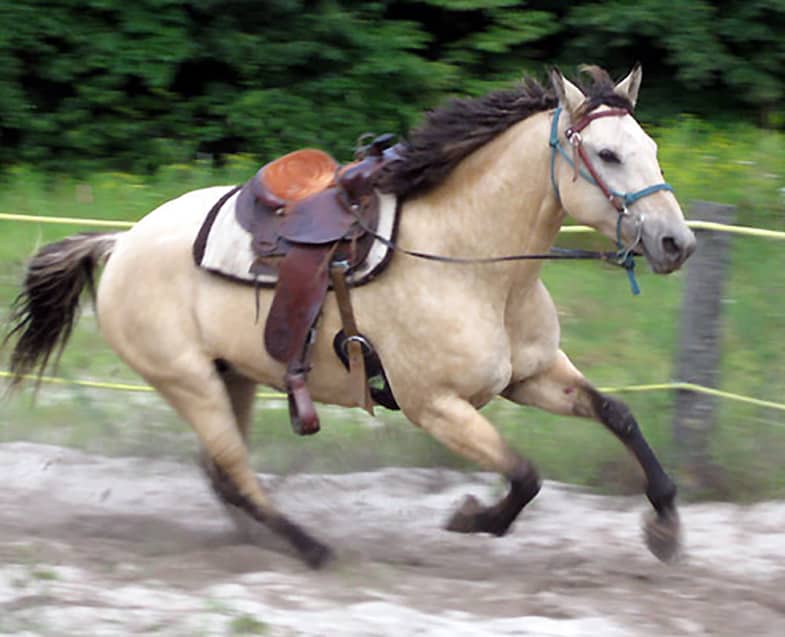There’s no doubt that the Bashkir Curly, with its trademark curly coat, is a distinctive breed but there’s more to these horses than meets the eye. With affectionate personalities and can do nature there really isn’t anything to not like about them – even if you’re allergic to horses! Read on to find out just how amazing these horses are.
Height: While horses can range from 13.3hh (55 inches) to 16hh (64 inches) most will stand at around 15hh (60 inches).
Color: They can be any color at all although chestnut is without doubt the most common, and most popular.
Personality: The Bashkir Curly is an extremely affectionate horse that loves to be around people, they are easy to train and have an outstanding work ethic.
Country of Origin: USA
Registry: American Bashkir Curly Horse Registry
An ancient characteristic
You might not have seen many curly-coated horses (I know I certainly haven’t) but that doesn’t mean they’re new at all. While they may not have been a distinctive breed, horses with curly coats have been depicted in ancient Chinese art dating back to 161 AD.
Some people have also suggested that horses with curly coats were present in ancient Europe and South America although this is only a theory as there is no evidence of horses being in South America before Columbus.
An unknown beginning
While there is evidence to show that curly-haired horses have been in existence for hundreds (if not thousands) of years nobody knows how they found their way to America. One thing that is known for sure though is that they’ve been here for over 200 years. An early 1800s Lakota Winter Count pictograph shows that during the 1803/1804 winter, they stole curly-coated horses from the Crow at the Standing Rock Indian Reservation on the border of North and South Dakota.
What’s in a name?
You might think that, due to its name, the Bashkir Curly is closely related to the Russian Bashkir horse but this isn’t actually true. For many years it was believed that they were descended from Bashkir horses but research carried out in 1990 by Soviet scientists, Moscow Zoo, and the Ministry of Agriculture found that there was no connection between the two breeds at all. Nor was there any connection between the Bashkir Curly and the Lokai, another Russian breed that is known to occasionally have a curly coat.
So why is the Bashkir Curly so called then I hear you ask? The answer is pretty simple really and is due to a 1938 edition of Nature Magazine. The cover of the March issue showed a photograph of a curly-coated Russian horse, this photograph was later recreated by cartoonist John Hix in his Strange As It Seems series. This same cartoon was later saved in a scrapbook by the Damele family who went on to create the Bashkir Curly breed we know today.
The lack of a Russian connection, and in particular any Bashkir blood, has led some people to question whether the Bashkir Curly should change its name. As you can imagine there’s a lot of opposition to a name change although that said, they are also known as North American Curly Horses or just American Curly Horses.
The modern curly horse
While it’s clear to see that curly-coated horses have been around for a long time, how did they go from a genetic variation in a variety of breeds to a breed in their own right? Believe it or not but this was actually by pure chance and due to the efforts of one family, the Damele family.
In 1898 Peter Damele was out riding with his father in Eureka, Nevada when he spotted three horses with tightly curled ringlets over their entire body. They were both intrigued by these unusual horses but it wasn’t until 1931 when they caught their first curly horse, a wild horse that they trained before selling him on. This could easily have been the first and only curly horse they owned if it hadn’t been for the harsh winter of 1932.
As the weather started to warm up the Dameles went to roundup the horses that had wintered outside only to discover that none of their horses had survived the extreme temperatures. The only horses they could find that had survived were curly-coated horses. After rebuilding their herd the same thing happened again after another extreme winter in 1952. Noticing that again only curly horses had survived they decided to begin a breeding program to produce curly-coated horses that could survive the elements, and the rest, as they say, is history.
The founding fathers
Having decided to create a curly-coated breed the Dameles set about finding the perfect stallion for this. They eventually found a wild two year old chestnut Mustang that they caught and named Copper D. To add a bit of diversity to the breeding stock they introduced a Morgan Horse called Ruby Red King and an Arabian known as Nevada Red.
Together these three horses went on to create the Bashkir Curly and most horses can trace their lineage back to one of the three founding stallions.
The famous curly coat
Let’s be honest, the curly coat is, without doubt, the most recognized feature of this beautiful breed, after all, it’s so recognizable that its name mentions it but did you know that they are curly from top to toe (well hoof but you know what I mean).
Their curls are far more prominent during the winter when they can range from tight ringlets to perfect marcel waves or can have a crushed velvet appearance. Not only is their body curly but so is the hair inside their ears, even their eyelashes are curly! As well as a curly coat, Bashkir Curlys also have a double mane that splits in the middle and falls on either side with curly ringlets, their tail can also be curly although these curls usually aren’t so tight.
Surprisingly only around 50% of all horses born to Bashkir Curlys have curly coats, that said though, while they have straight hair they do carry the ‘curly gene’.
During the summer, most horses will shed their long winter coats and lose their tight curls although their hair will generally have a wave to it. Some horses will completely lose their curls in the summer and have straight fur.
A true hypoallergenic horse
Along with a pretty unique coat pattern, the actual hair of the Bashkir Curly is unlike any other horse in that it’s round. Most horses have flat hair but the Bashkir Curly’s fur is closely related to the hair of the Angora Goat.
As well as being a different shape to that of other horses the hair of the Bashkir Curly is also hypoallergenic so it is great for people who are allergic to horses. In fact, a 2017 study found that somebody who was allergic to horses was able to be cured of their allergy by regularly riding and grooming Bashkir Curlys.
Some Bashkir Curly owners collect the hair when their horses shed their winter coats and sell it. It’s then spun into yarn to make hypoallergenic woolen sweaters for people who are allergic to wool.
A love of human contact
Everybody says how much their horse loves them and how they love to be with them but a Bashkir Curly is like that with everybody (unless of course, you mistreat them). They crave being around people and love being talked to but they won’t tolerate abuse and find it very hard to cope with being mistreated.
Love your Bashkir Curly and they’ll give you much more love back.
The gentlest of natures
One of the many things that Bashkir Curlys are highly prized for is their easygoing nature. This laid-back attitude makes them great family horses that can easily be trusted around children, even unsupervised.
As well as being perfect for children, their gentle nature means that they’re also ideal for use in equine assisted therapy.
A horse for all purposes
The Bashkir Curly has a can-do attitude which means they’re happy to do pretty much anything that’s asked of them. This means that they can be seen in a wide range of disciplines such as Western Riding, reining, gymkhana, jumping, roping, English equitation, dressage, driving, and even endurance trail riding.
They’re extremely surefooted and are a popular choice for ranch work in mountainous regions.
They don’t scare easily
Unlike a lot of other breeds (with the exception of the Icelandic Horse) Bashkir Curlys aren’t prone to taking flight in the face of something scary. Instead, their curious nature means they prefer to investigate something rather than to run away. If they do feel threatened then they’re more likely to kick out rather than run.
As well as facing up to danger they also tend to freeze if (or more likely when) they get themselves into a tight spot, even if they end up caught in barbed wire. This means that they’re far less likely to hurt themselves struggling to get free.
A tough horse built to survive
We often talk about horses being tough and able to survive in harsh conditions but there aren’t many breeds that are as hardy and resilient as the Bashkir Curly. With their long thick, curly winter coats they can happily live outside in the most of extreme winters. Their double manes also help to block out the coldest of winds too. While most owners may choose to give their horses food supplements during the winter it’s not something that Curlies need.
Even their hooves, which are almost perfectly round are tough and need minimal care throughout the year.
Fancy a dance?
With a lot of Morgan Horse blood in their ancestry, some Bashkir Curlys are naturally gaited and have a unique stepping pace known as the curly shuffle. Similar to the foxtrot that’s performed by the Missouri Foxtrotted, the curly shuffle is a smooth gait that has a lot of rhythm.
Around 10% of all Bashkir Curlys can perform the curly shuffle but it’s a beautiful gait to watch.
Related questions
Are Bashkir Curlys good for beginners?
The Bashkir Curly is known, and loved, for its kind friendly temperament, the same temperament that makes it a good choice for beginners. They have sweet natures and are extremely eager to please. They also love to be around people and can easily be handled by children.
Want to learn to ride? How long does it take to learn to ride a horse?
How much do Bashkir Curlys cost?
Like so many breeds the cost of the Bashkir Curly depends on the horse’s pedigree as well as on its training. For an unregistered Curly that’s been trained you can expect to pay around $2,000 to $3,000. A registered horse can sell for in excess of $6,000 while a breeding stallion can fetch as much as $40,000, although I’m sure this is an extreme.
I hope you found this article helpful. If you did I’d be grateful if you could share it please as it would really help me.
Recommended products
Over the years I have tried hundreds of different horsey products, from various blankets and halters to different treats. Some I’ve loved, others I’ve hated but I thought I’d share with you my top all-time favorite products, the ones I never leave the yard without. I’ve included links to the products (which are in no particular order) that I really think are great.
- Horse Knots by Reference Ready – If you’re like me and enjoy pocket reference guides then you’ll love this knot tying guide. These handy cards can easily fit in your pocket or attach to the saddle for quick reference. They’re waterproof, durable and are color coded to make them easy to follow.
- Mane ’n Tail Detangler – Even if you never show your horse you’ll need to detangle his tail from time to time (and possibly his mane too) which is always a challenging chore! I’ve found that if I run a little bit of detangler through my horse’s tails every few days it stops them from getting matted up and makes combing them easy, even if they’re coated in mud. I don’t know if I should admit to this or not but it also works wonders on my hair.
- TAKEKIT Pro clippers – Over the years I’ve tried a lot of different clippers and while some were obviously better than others I found these to be by far the best. They are heavier than a lot of other clippers but for me, that’s a good thing, it makes them feel more sturdy and hardwearing. On top of that they have a range of speeds so are just as good for clipping your horse’s back as they are his face. I also like the fact that they come in a handy carry case but that’s not for everybody. The company that makes them is super good and incredibly helpful too, a real bonus these days. The only thing I wasn’t keen on was the fact that it doesn’t come with any oil, but that’s not a major problem as it’s not difficult to buy lubricant.
- Shire’s ball feeder – There are so many boredom buster toys out there but I like to use these every day, regardless of whether or not my horses are bored. I find that it helps to encourage my horses to problem solve by rewarding them with treats (or pieces of fruit) but it also mimics their natural grazing behavior which helps to keep them calm and de-stressed.
- Horse safe mirror – This is a strange one that many people are surprised about but I like to put horse safe mirrors in the trailers as well as in the quarantine stalls. It helps to prevent the feeling of isolation by giving the impression of other horses being around. Being herd animals horses can get extremely stressed when they feel that they’re on their own but with these stick-on mirrors, they believe that at least one other horse is with them.
- Rectal thermometer – I know this isn’t glamourous at all but it’s vital for your horse’s well-being to be able to check their temperature and a rectal thermometer is the easiest way of doing this which is why I’ve added it to the list.
Shopping lists
I’ve also put together a few shopping lists of essential items that I’ve found helpful over the years. I’ve broken the lists down into different categories rather than put everything in one massive list 😉





